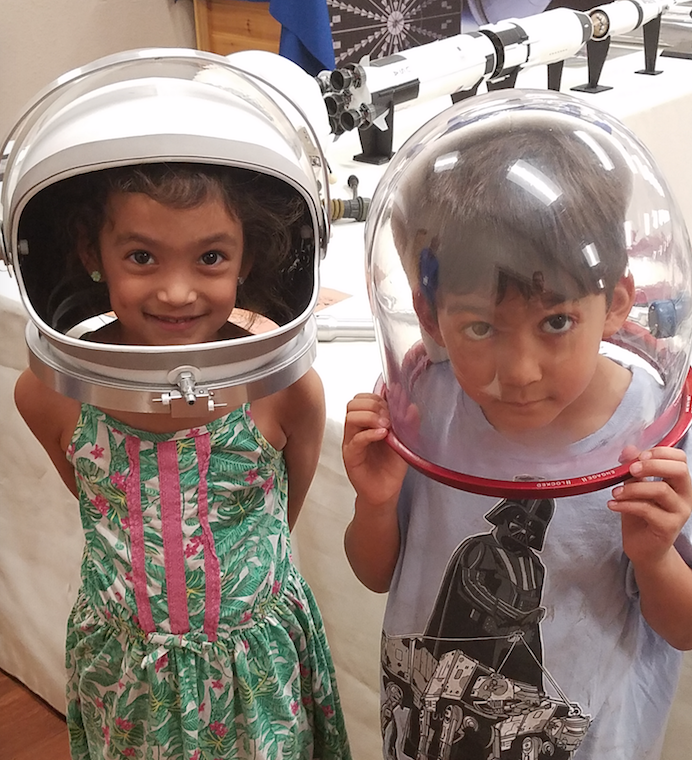Former astronaut tells kids, 'reach for the stars'

Lew K. Cohn/The Highlander
Magnolia and Zellam Payson try on austronaut helmets at the annual Hill Country Space Expo at the Marble Falls Boys & Girls Club Saturday, Sept. 30. The two five-year-olds attended with their mother Kathy Payson to meet former NASA austronaut Capt. Dan Bursch and learn about a path to the stars.
By Lew K. Cohn
Managing Editor
The Highlander
Former NASA astronaut Capt. Dan Bursch knows how important science, technology, engineering and mathematics (STEM) education is for the next generation and is glad to see events like the Hill Country Space Expo bringing exhibits and artifacts to kids.
“I think the most important thing for kids right now is getting them interested in science, technology, engineering and mathematics,” Bursch said. “Events like these are dealing with real people, real hardware and real stories.
“There are things you can get off the internet which are great, but it is better when you can meet the people who did this and they can describe and see models and to see the kids start thinking, 'Wow, this stuff really happened! This is a real bolt that held the space shuttle to the launch pad before it launched and it is the real one that was actually used to do that!'”
Encouraging them to continue reaching for the stars, Bursch spoke to more than 500 area students this past week during the expo at the Boys & Girls Club of the Highland Lakes, Marble Falls Unit, 1701 Broadway.
The free expo was sponsored by the Wreyford Family Foundation with assistance from Winans Invesments, the W Foundation, Astronaut Scholarship Foundation and the Boys & Girls Club of the Highland Lakes.
A 1979 graduate of the U.S. Naval Academy, Bursch took part in four spaceflights, the first three of which were as a Space Shuttle mission specialist aboard Discovery on STS-51 in 1993 and aboard Endeavour on STS-68 (1994) and STS-77 (1996).
In December 2001, Bursch launched aboard Endeavour on STS-108 to the International Space Station, where he was flight engineer for Expedition 4 crew and stayed six and a half months aboard the ISS, setting a U.S. space flight endurance record of 196 days that lasted until 2010.
Bursch himself logged nearly 12 hours of spacewalk time outside the ISS and returned to Earth aboard STS-111 in June 2002.
Bursch left NASA and retired from active duty in 2005 after 26 years of service in the U.S. Navy and currently serves as the National Reconnaissance Office (NRO) chair at the Naval Postgraduate School in Monterey, California.
He said he loves to see the reaction of school children as they learn about space and technology.
“It is great to see the kids' eyes and their enthusiasm,” Bursch said. “Their eyes light up when you tell them a story and they get really big. If you tell them, 'I am an astronaut,' they want you to tell them more about it. During this expo, I have met some kids who are determined they want to go to Mars and that is awesome.”
Bursch said science and space exploration remain important because while the constants of physics remain unchanged, the methods used to get to space are evolving.
“We are now seeing things like how (aerospace manufacturer) SpaceX is reusing first-stage rockets, which is exciting,” Bursch said. “That's why we want to encourage kids' imaginations to go wild about what they want to do, since that is the future.”

